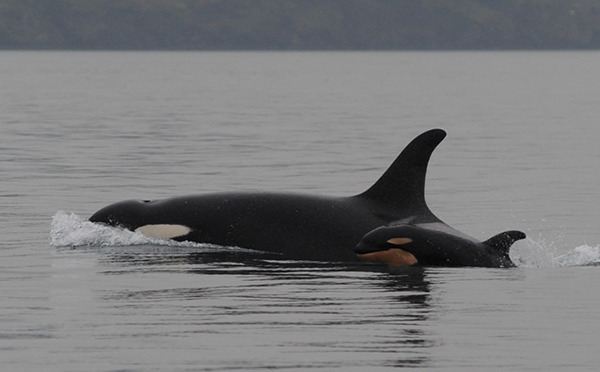The well-seasoned hands at the Center for Whale Research pretty much had written off J-19 for another go around at motherhood.
The 36-year-old female had last given birth nearly a decade ago, but it turns out she had a little surprise in store.
The Center believes J-19 is the mother of new calf sighted off the west side of San Juan Island in mid-morning of Feb. 12. Center biologist and photographer David Ellifrit said the calf appeared to about a week old and seemingly healthy as it traveled north, snugly tucked between J-19, AKA Shuchi, the name of a Hindu goddess of wrath and jealousy, and its first-born, J-41, a female also known as Eclipse.
“It’d been almost 10 years since her last calf,” Ellifrit said. “We had all but given up on her having another one. It’s a nice surprise.”
An unexpected surprise and hint of a mini-baby boom for the Southern Resident killer whales, whose population, with the addition of two J-pod calves in less than two months, now totals 79. Ellifrit said J-50, a newborn first sighted in late December, was among the killer whales seen Feb. 12 and appears to be thriving as well.
The arrival of two newborns stands as welcome uptick for endangered killer whales. The population, which consists of three tightly knit clans, J, K and L pods, fell to a 30-plus-year low, 77 individuals, as recently as late fall. Five of its members, including an early September newborn, vanished in 2014 and are presumed dead.
Prior to the birth of J-50, and now J-51, no member of the Southern resident had given birth to a calf that survived in the past two years. The mortality rate is roughly 50 percent for newborn orcas in the wild, according to the center.
Granted federal protection under the Endangered Species Act in 2005, the population of Southern residents totaled 86 animals at the time. The National Marine Fisheries Service, tasked with restoring the population, estimates that 2.3 newborns would need to survive each year for the population to recover. Lack of food, Chinook salmon is the Southern residents preferred prey, pollution and vessel disturbance are the three leading threats to the population’s survival, according to NMFS.
As of late, it’s been advanced-aged females that have given birth to the newborns that have survived, as well as the two most recent calves. The calf first sighted in late December, J-50, is presumed to be the offspring of J-16, a 42-year-old female.
Pregnancies are a long-term endeavor for female killer whales, which typically carry a calf for about 17 months before giving birth. While the arrival of two newborns are a welcome sign for the killer whales, Ellifrit said it would be encouraging and more in keeping with patterns of the past to see the population’s younger females producing newborns that survived.
“It’s nice that we’re having calves with the older females,” he said. “Now we’d like to see some of the younger ones having them too.”




